
It's been a significant quarter: very large inflows continue into ETFs, sentiment is high, the Trump agenda has waxed and waned but is still alive, and the global economy continues to slowly improve.
The world wanted stocks in the first quarter. We can see this in the numbers: the U.S. markets did well, with the up 5.8 percent, but Europe also did well, and even emerging markets were strong.
Global ETFs in Q1
(SPY) up 5.6 percent
Europe (EZU) up 9.0 percent
Emerging markets (VWO) up 11.2 percent
But U.S. stocks had seen significant rotation in the first quarter:
S&P: up 5.7 percent
Russell 2000: up 2.3 percent
Tech: up 12.4 percent
Banks: down 0.6 percent
Energy: down 7 percent
A nearly 20 percentage point spread between technology and energy stocks is an enormous difference in a single quarter! This is certainly a strong argument for a diversified portfolio!
Technology did well as the uses for semiconductors have expanded into almost any object that can give off information. But energy stocks suffered as it became apparent that oil wasn't going to rally significantly despite an OPEC agreement to cut production.
And bank stocks gave back about a third of their massive gains since the election as the yield curve has failed to steepen significantly and the hope for fewer regulations has faded a bit.
Where do we go from here? I've said several times this is all about confidence, confidence on three levels:
1) On the economy. Consumer confidence is at the highest level since 2000. Skeptics note that the "harder" economic numbers have not seen the jump that softer, "sentiment" indicators have seen. And Q1 GDP estimates are certainly disappointing: my colleague Steve Liesman noted that the median estimate for Q1 is now 1.4 percent. But, as Steve has also noted, betting on a second-quarter bounceback in GDP has been a pretty good trade over the last few years.
2) On earnings. Q1 earnings are tracking up roughly 10 percent, the best showing in nearly six years,
3) On the Trump agenda of lower taxes, infrastructure spending and fewer regulations.
The rest of the year will be about the tension between those three factors.
How to balance these factors?
1) don't underestimate the Trump agenda influence. Those who doubt the influence of the Trump agenda on stocks should consider this: the third week in March saw the first negative week since the election; that was the week the House failed on its Obamacare repeal bill.
If you want a single-ETF referendum on the Trump agenda, you probably can't do better than the Russell 2000 ETF (IWM): rocketing up 17 percent from the election to mid-December, but then hit its low for the year on March 27, the day after the House vote to repeal Obamacare failed.
2) But don't overestimate the Trump agenda as well. The tenor of the overall market is still about global growth, most traders still think it can pick up the slump if the Trump agenda lags. Remember, the reflation trade was happening before Trump was elected, even if it gained steam after.
3) Earnings will be strong, but the market has already priced that in. I've said for two weeks that earnings are expected to be up 10 percent in the first quarter, the strongest gains in nearly six years. But the market is expensive, trading well above 18 times 2017 earnings. It's quite possible — likely even — that we will achieve these lofty numbers but the market weakens when guidance is not as strong as expected. Expectations are that earnings will rise 10 percent in the second quarter as well.
Bottom line? The overall market seems like a solid hold.
I know that sounds wimpy, but that's exactly the way the market is acting. Traders expecting fireworks going into the end of the quarter have been greatly disappointed: volumes have been 20 percent below normal for most of the last two weeks, and volatility has again collapsed, with the CBOE Volatility Index (VIX) back at 12 (it hit a 10-year low in February).
Finally, what would cause the long-awaited correction, even a modest correction of, say, 10 percent? Aside from a black swan event, what really drives drops in the market are major declines in earnings that follow economic declines.
I don't see that on the horizon. Me? I'd rather bet on global growth than solely on the Trump agenda sailing through. You don't want a rally riding just on that.


